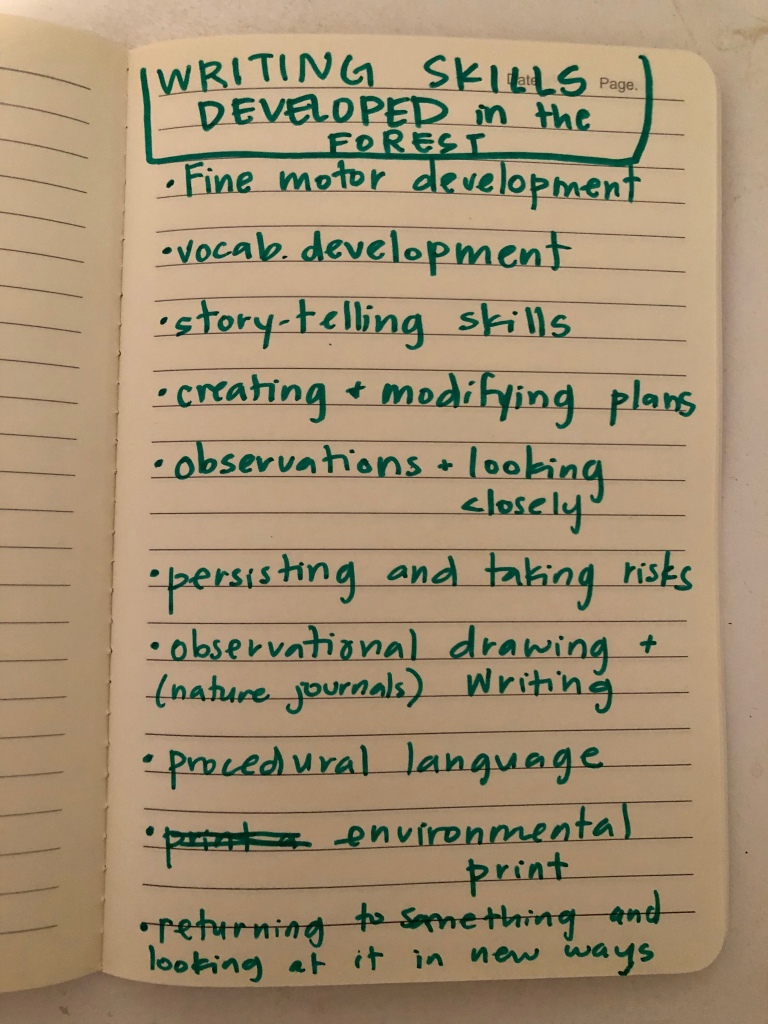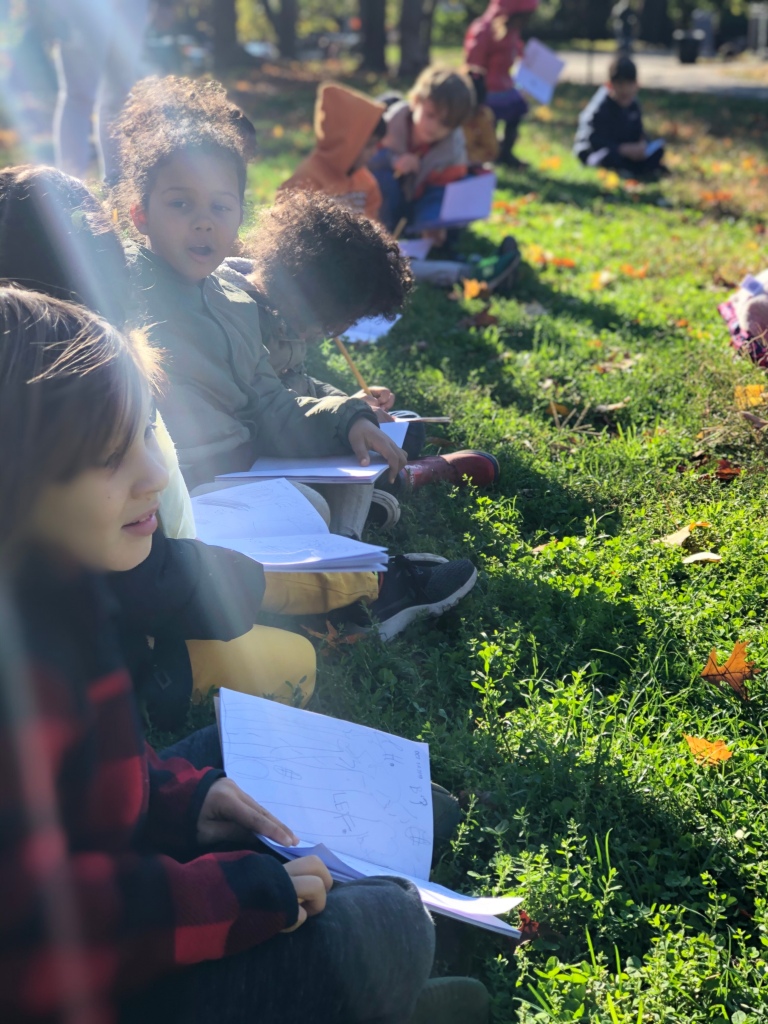
On mornings in Brooklyn, people on their morning commutes stop to watch and greet 27 kindergartners, waddling along with the swish swish swish of their blue body suits. “Where are you going?” passersby often ask, to which the children reply:
“We’re going to the forest!”
For these kindergartners, among others at neighboring schools in Brooklyn and Manhattan, school takes place in the forest (AKA a city park) on one morning each week — a concept known as Forest School.

The roots of Forest School can be traced back to the 1950’s in Scandinavia. Now, Forest School Associations exist around the world, as a movement for children to spend more unstructured time outdoors has spread. Many pre-kindergartners or kindergartners in a Forest School model are outdoors full-time.
Key principles of Forest School outlined by the Forest School Association of the UK include:
- It is a long term process with regular contact with a local wooded environment (preferably over the seasons).
- It follows a child-centred pedagogy where children learn about and manage risk.
- It has a high adult:child ratio.
- Observations of the learners are key to enabling scaffolding of the learning.
- Care for the natural world is integrated.
In Helping Children to Love the Earth Before We Ask Them to Save It, research from the Dimensions Education Research Foundation has found that “appropriate experiences with nature bring significant benefits to children. A few of these benefits are outlined below:
- Children with Attention Deficit Hyperactivity Disorder (ADHD), when provided appropriate contact with nature, show an improvement in their ability to concentrate (Taylor 2001)
- Children who regularly have positive personal experiences with the natural world show more advanced motor fitness, including coordination, balance and agility (Grahn, 1997, Fjortoft 2001)
- Appropriate interactions with nature help children develop powers of observation and creativity (Crain 2001)
- The development of imagination and a sense of wonder have been positively linked to children’s early, appropriate experiences with the natural world (Cobb 1997). A sense of wonder is an important motivator for life-long learning (Wilson 1997).”

Committing to Forest School one morning each week means missing missing several hours of (indoor) classroom time. While we are certain that what children gain from doing so far surpasses the core-curricular time that is lost, my co-teacher, Madeleine, and I need to make thoughtful and intentional (and oftentimes, creative) plans for integrating literacy with Forest School.
In any kind of play, content areas can be integrated by:
- Framing what children are already doing through play in the context of writing*.
- Creating opportunities for children to engage in writing within play.
- Turning shared play experiences into shared writing experiences.
*For the sake of this post, I will describe how this process can look in the context of writing. Though, any content area can be applied.
1. Framing What Children Are Already Doing Through Play in the Context of Writing
When it comes to justifying play, indoors or out, this step is key. Begin by thinking about all of the writing or writing-related skills that can be developed in play (observing children through this lens can be helpful with doing so). Keeping a list of these allows us to better facilitate, document, and support children with building such skills while they play.
Here’s a list that Madeleine and I began generating of writing skills children can develop at Forest School:


2. Creating Opportunities for Children to Engage in Writing Within Play
The work of Forest School is meant to be children-led and teacher-facilitated. Additionally, the tools children use to explore and play are to be found in nature. Few materials from the classroom are brought (if any) and might include buckets, shovels, magnifying glasses.
Though it is not a traditional practice of Forest School, our kindergarten team decided to add a time to sketch and write in nature journals. This practice aligns with much of the big work of kindergarten — looking closely, making observational drawings, and labeling.
Each week, we date stamp the top of a new page in each child’s nature journal. This becomes a visual for where to write as well as a record to help us observe growth. So far, we have given children a prompt to guide their journaling, though in the future this may become open-ended.


To include a component of writing, the structure of our Forest School looks like this:
- Community gathering for a song and snack around the Beech tree stump –about 10 minutes
- Free play in the park (within specific boundaries) –about 30 minutes
- Observational nature walk to the forest (a more tree-dense area of the park) –about 5 minutes
- Meeting in the forest (where we remind children of boundaries and rules) –about 5 minutes
- Nature journaling –5-10 minutes
- Forest play (about an hour)
3. Turning Shared Play Experiences into Shared Writing Experiences
Shared experiences become even more memorable after shared opportunities to write about them. Noticing purposeful and authentic opportunities to write from play will help children see moments in their everyday lives as worthy of writing.

In the hours, days, or weeks following Forest School, we’ve created, through shared and interactive writing:
- Pattern books to add to independent book baggies (i.e., “What Can We See in the Forest?”)
- Small-moment stories
- Recipes and procedural texts for a pre-forest school baking ritual
- Persuasive signs to protect the forest
- Poems
- Lists of questions to research
Connecting Children with Nature in Small and Big Ways
One of the biggest ideas behind Forest School is that deep connections with nature are formed when a wooded place is revisited across the seasons.

- If weekly visits aren’t possible, consider monthly visits.
- If a wooded area isn’t accessible via walking or bus, consider alternative places where kids can play in a natural environment nearby.
- If play time is not an option, consider observing and writing about an outdoor tree or garden routinely throughout the year.
- Bring living things indoors by having plants and classroom pets. Children who choose the “living things” center at work time have become much more comfortable and connected with our class stick bugs since the beginning of the year.

To support my learning about Forest School, I am reading:
- Beyond Ecophobia, by David Sobel, or this recap of Sobel’s work
- Forest Kindergartens, the Cedarsong Way, Erin Kenny
- Helping Children Learn to Love the Earth Before We Ask Them to Save It, Dimensions Educational Research Foundation
- Nurturing Children and Strengthening Conservation through Connections to the Land, Conservationtools.org
- https://www.forestschoolassociation.org/what-is-forest-school/
Please share nature stories or Forest School questions below!



What a great idea!
LikeLiked by 1 person
Thank you so much for sharing your ideas about how children are and can develop writing skills in the wild, something any teacher can apply. The dedication to giving students an authentic opportunity to play in nature for such a wonderfully rich about a time is commendable.
LikeLiked by 1 person
You might be interested in an article I wrote. https://educate.bankstreet.edu/occasional-paper-series/vol2015/iss33/8/
LikeLiked by 1 person
Absolutely! Downloaded and sharing with my colleagues. Thanks so much!
LikeLike
Thank you for this wonderful post! I am a volunteer at a local horticulture garden (Longwood Gardens) and I love helping young children develop that sense of wonder and curiosity. I loved reading about Forest School and the way you incorporate writing into the play based curriculum. What a fantastic way to learn!
LikeLiked by 1 person
Thank you! Gardening is also such a special and important experience for children.
LikeLike
There is so much to be gained from time in nature, Kelsey. I’ve been fascinated by the Forest School concept and Sobel’s work. I am fortunate that my school has shifted all of our science curriculum to a place-based focus (see Sobel’s Place-Based Education: Connecting Classrooms and Communities), but I am still distressed at the lack of time in a daily schedules for time outdoors and and play in general. Thank you for sharing this piece!
LikeLiked by 1 person
I agree, completely! I can’t wait to check out Sobel’s Place-Based work, thank you for sharing!
LikeLiked by 1 person
I want to go to the forest!
What an extraordinary opportunity you’re providing for your students. I’m definitely going to check out our local nature preschool for Ari because of your post!
LikeLiked by 1 person